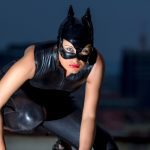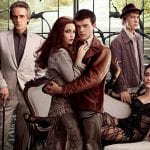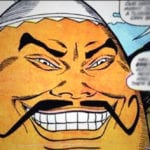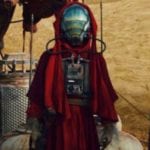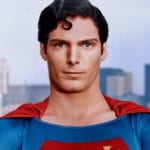 Movies and TV
Movies and TV  Movies and TV
Movies and TV  Health
Health 10 Miraculous Advances Toward Curing Incurable Diseases
 Miscellaneous
Miscellaneous 10 Undeniable Signs That People’s Views of Mushrooms Are Changing
 Animals
Animals 10 Strange Attempts to Smuggle Animals
 Travel
Travel 10 Natural Rock Formations That Will Make You Do a Double Take
 Movies and TV
Movies and TV 10 Actors Hidden in Your Favorite Movies
 Our World
Our World 10 Science Facts That Will Change How You Look at the World
 Pop Culture
Pop Culture 10 Incredible Female Comic Book Artists
 Crime
Crime 10 Terrifying Serial Killers from Centuries Ago
 Technology
Technology 10 Hilariously Over-Engineered Solutions to Simple Problems
 Movies and TV
Movies and TV 10 Movie Adaptions That Brought Popular Songs to Life
 Health
Health 10 Miraculous Advances Toward Curing Incurable Diseases
 Miscellaneous
Miscellaneous 10 Undeniable Signs That People’s Views of Mushrooms Are Changing
Who's Behind Listverse?

Jamie Frater
Head Editor
Jamie founded Listverse due to an insatiable desire to share fascinating, obscure, and bizarre facts. He has been a guest speaker on numerous national radio and television stations and is a five time published author.
More About Us Animals
Animals 10 Strange Attempts to Smuggle Animals
 Travel
Travel 10 Natural Rock Formations That Will Make You Do a Double Take
 Movies and TV
Movies and TV 10 Actors Hidden in Your Favorite Movies
 Our World
Our World 10 Science Facts That Will Change How You Look at the World
 Pop Culture
Pop Culture 10 Incredible Female Comic Book Artists
 Crime
Crime 10 Terrifying Serial Killers from Centuries Ago
 Technology
Technology 10 Hilariously Over-Engineered Solutions to Simple Problems
10 Comic Book Characters That Didn’t Originate in the Comics
Just since the year 2000, when the original X-Men movie premiered, there have been well over 100 live-action movies and television series that featured comic-book-inspired superheroes. Then there are the countless animated movies and television series since then. And yet, the opposite is not true.
Very few of these shows have impacted the comics, and fewer still create characters that become a part of the comic canon. Such rare characters are called canonical immigrants. Here are 10 characters that started out in other mediums but ultimately became recurring characters in comics.
Related: Top 10 Worst Comic Supervillains
10 Batgirl (DC: Batman titles)
For comic book historians, April 14, 1954, was a watershed moment. That was the day Fredric Wertham published Seduction of the Innocent, a warning that the overt violence and hidden references to sex and drugs in comics could encourage criminal activities in kids. While not the moral screed it is often portrayed, a 2012 study of Wertham’s evidence found that he falsified and twisted data to fit his theories. A week after Seduction’s publication, Wertham appeared before the Senate Subcommittee on Juvenile Delinquency which was televised. Wertham told the committee and America that comics were more of a threat to youths than Hitler had been to the world. People panicked, and parents across the nation began canceling subscriptions and throwing comic books in the trash. That summer, 15 comic book publishers went out of business, and the surviving publishers launched the Comics Code Authority to rescue their reputations and sales.
Sales for Detective Comics—better known as DC comics—also took a hard hit after Wertham claimed Superman was a fascist, Wonder Woman was a lesbian, and Batman and Robin were gay lovers. In 1956, to repudiate the latter claim, DC introduced a love interest for Batman in the guise of Kathy Kane, who, like Batman’s alter ego, had inherited a fortune and, like Robin’s alter ego, was a circus performer. And she was also combating crime as Batwoman. In 1961, feeling Robin—who had for 20 years been perpetually a teenager—was left out, DC introduced Betty Kane, a niece of Kathy’s, as Robin’s love interest. Betty also idolized Batwoman and designed her own costume and gadgets to become Bat-girl (with a hyphen). But Bat-girl never caught on, and when the legendary editor Julius Schwartz took over as head of the Batman titles in 1964, he dropped Bat-girl along with other Bat-Family members such as Bat-mite and Bat-hound.[1]
In 1966, the live-action Batman series debuted on television, and its success re-sparked interest in the Batman titles and may have even saved them. But by the third season, the show’s ratings were dropping, and producer William Dozier—who was also the narrator—came up with an idea to add a female hero to the show to appeal to female viewers. Dozier went to Schwartz, asking him to develop a female character who was the daughter of an already established character, Commissioner James Gordon. Schwartz—along with Gardner Fox, creator of Justice Society and Justice League of America—took that idea and created Barbara Gordon, a librarian by day and Batgirl by night. Artist Carmine Infantino created her look.
But the ABC executives needed to be convinced Batgirl was needed in the show, so Dozier created an eight-minute short where Batgirl rescued Batman and Robin from the villain Killer Moth. Batgirl was not allowed to punch Killer Moth because that was too un-lady-like. She instead became a kicker. Dozier then asked Schwartz to introduce Batgirl in the comics to create a buzz for the upcoming season of Batman. So Batgirl appeared first in Detective Comics #359 (January 1967), but only after she was created for television. Since then, several women have worn Batgirl’s cowl, and she is a regular in the Batman titles. She has now and then been given her own title, and work has already begun on a Batgirl movie.[2]
9 Firestar (Marvel: X-Men titles
Spider-Man and His Amazing Friends was a Saturday morning cartoon series that debuted in 1981 on NBC and ran for three seasons. It went in an unusual direction by placing Spider-Man’s alter ego, Peter Parker, as a college student at Empire State University with two roommates who are also superheroes: Iceman (Bobby Drake) and Firestar (Angelica Jones). The producers originally wanted a fire and ice theme in Spidey’s roomies and wanted Iceman from the X-Men and the Human Torch (Johnny Storm) from the Fantastic Four. But Universal Studios had optioned the Human Torch character for a potential solo project that ultimately never happened. As a result, the Human Torch could not be used by anyone. So the producers created their own character with the ability to manipulate microwave radiation to fly and shoot flames from her hands.
Some of the names the production toyed with initially were Heatwave, Firefly, and Starblaze. One of the writers, Dennis Marks, christened Firestar’s alter ego—Angelica Jones—after an old girlfriend. In the show, Firestar is identified as a former X-Men along with Iceman, but when her backstory was fleshed out in the comics, she is initially trained as a Hellion at the Hell Fire’s Club. One of her earliest missions was to fight against the X-Men. Later she joined the New Warriors, where she became a hero and was even given her own comic-book miniseries.[3]
8 Jimmy Olsen (DC: Superman titles)
It’s hard to imagine Superman or his alter ego Clark Kent without his BFF Jimmy Olsen, but Jimmy has sat out a portion of Superman’s 83-year history. It’s true that just months after Superman’s introduction in the summer of 1938, Action Comics #6 had an anonymous young man with red hair and freckles arrive in Metropolis staring dreamily at a billboard that declares the city is the “Home of Superman!” He muses, “I’m going to get a job and live in Metropolis. Gee, wouldn’t it be wonderful if I met Superman! But I won’t have that luck.”
Later, DC would retcon that character to be Jimmy Olsen. But in reality, the character wasn’t introduced until Olsen became a cub reporter for the newspaper The Daily Planet during the April 15, 1940, radio program The Adventures of Superman. The radio serials relied almost entirely on conversations and sound effects to tell the story, and Jimmy Olsen—and The Daily Planet’s head editor Perry White–were created as conversation foils for the program. Jimmy became so popular, his comic book persona was introduced in the November/December 1941 issue of Superman #13.
After a few more appearances, Jimmy Olsen disappeared from the Superman titles for most of the 1940s, considered the Golden Age of comics. But in 1952, Olsen was resurrected in the television series Adventures of Superman, and interest in the reporter/photographer reignited. In 1954 and lasting nearly 20 years, Olsen had his own title called Superman’s Pal Jimmy Olsen. Perhaps the title was best remembered for the issues where Olsen was transformed into everything from a monster-sized turtle, a genie in a bottle, a human porcupine, a six-armed octopus (a sextapus?) and Elastic Lad, an early version of Elongated Man. In this title, readers were first introduced to Darkseid, the New Gods, and the cast of characters in the Fourth World.[4]
7 Phil Coulson (Marvel: Avengers titles)
The Marvel Cinematic Universe (MCU) encompasses to date 25 movies, more than a dozen television series, and a handful of podcasts. And what actor has had more screen time than any other? That’s right, Clark Gregg playing Agent Phil Coulson. Introduced in the first MCU movie—Ironman (2008)—he appeared in four more movies, two straight-to-video shorts, one web series, and all 136 episodes of ABC’s Agents of S.H.I.E.L.D. Gregg’s Coulson had a small and easily forgettable part in Ironman annoying Pepper Potts and Tony Stark before helping them thwart Obadiah Stane’s plans to murder them. But Gregg made the most of his role. Samuel L. Jackson’s Nick Fury didn’t appear until the post-credit scene of that film, and both he and Gregg appeared in the sequel Ironman 2 (2010).
A year later, it looked as if the MCU was finally going to be launched with the release of Thor and Captain America: The First Avenger before the release of an Avenger movie in 2012. But the script for Thor was scrapped just weeks before principal filming, and writers Ashley Miller and Zack Stentz were tasked with quickly writing a new screenplay. While piecing together the story, Miller and Stentz decided that they needed S.H.I.E.L.D. to be involved. But Samuel Jackson was still negotiating his contract to play Fury, and with time growing short, they turned to Gregg’s Coulson. This led to a pivotal role in Avengers (2012) and the lead in Agents of S.H.I.E.L.D. beginning in 2014.
Coulson had become so popular with the first two Ironman movies that he appeared in comic books for the first time in issue #6 of the 2011-2012 series Battle Scars that delved into Nick Fury’s backstory. Coulson was an Army Ranger serving in Afghanistan, fighting alongside and saving the life of Marcus Johnson, Nick Fury’s son. In the comics, Coulson was given the responsibility to work with superhumans because he collected their memorabilia and studied their strengths and weaknesses. This made him exceptionally gifted in dealing with challenging personalities such as Tony Stark, Bruce Banner, and Wade Wilson (aka Deadpool).[5]
6 Sakura Kasugano (UDON: Street Fighter titles)
It may not seem so remarkable that Sakura Kasugano did not originate from comic books. After all, if you know who she is, you most likely encountered her in one of the many other mediums she has appeared in, specifically a Capcom Street Fighter game from 1994 onward. In 2017 when Street Fighter turned 30, Capcom polled fans to see who was the most popular out of the 109 playable Street Fighters they’d introduced both in the mainline games and spin-offs. After more than 150,000 votes, Sakura topped the list. Her boyfriend and mentor Ryu, considered the protagonist of the Street Fighter series, only made 9th place. Of the dozen original characters from the first Street Fighter arcade game, Sagat was 7th, Ken 15th, Gen 30th, Adon 33rd, Eagle 60th, Retsu 69th, Geki 80th, Birdie 87th, Joe 96th, Mike 99th, and Lee 100th.
Sakura’s creator Akira Yasuda gave her an unusual look, a Japanese schoolgirl uniform with a mini-skirt, sailor blouse with a yellow scarf tied in front, red sneakers and red combat gloves, and a white headband Ryu gave her. Her personality was also made to be relatable to a young audience, as she was a teenager and awkward, yet skilled in Ryu’s “Shotokan” fighting style. She has appeared in at least 21 different video games, almost all of them as a playable street fighter. She has also appeared in anime and American animated television productions. She was a lead character in a straight-to-home video live-action movie, the subject of a manga series, and appeared in at least 70 issues of Street Fighter comic book titles.[6]
5 Rocksteady and Bebop (IDW Comics: Teenage Mutant Ninja Turtles titles)
Of all the villains the Teenage Mutant Ninja Turtles (TMNT) face, Shredder and Krang are the most formidable. But the most beloved are the giant warthog and rhinoceros Bebop and Rocksteady. When Peter Laird and Kevin Eastman created and published the first TMNT comics in 1984, it was inspired by characters such as Marvel’s Daredevil and the New Mutants, along with Frank Miller’s Ronin, and the self-published comic about an anthropomorphic aardvark named Cerebus. For instance, the turtles—like Daredevil—have a Ninjitsu mentor, their archenemy was the Foot (a play on Daredevil’s the Hand), and are mutated by a mysterious liquid in a container that fell off a truck. While a parody, the story in that first comic was adult, featuring dark subjects such as the beating of a girlfriend, revenge, drug and arms smuggling, and murder. There was little room for comic relief characters such as Rocksteady and Bebop.
In 1987, while negotiating with Playmate Toys for a line of toys based on TMNT, Eastman and Laird were asked to develop more characters for the line. Laird developed Bebop and Rocksteady for them, something he would soon regret. Bebop was named after a form of jazz music, Rocksteady after a type of Reggae music. The next year, the animated Saturday morning series Teenage Mutant Ninja Turtles premiered, geared more for kids, the storyline tweaked to be more light-hearted. And Bebop and Rocksteady were made to be deeply stupid, inept, and goofy. This made them a fan favorite for everyone but Laird. His animosity toward the characters was part of why they did not appear in the second 1991 TMNT movie. Instead, a mutated gray wolf (Rahaz) and alligator snapping turtle (Tokka) were introduced. Bebop and Rocksteady made their first comic book appearance in 1988 when the title was published by Archie Comics. In 2011, the titles moved to IDW Comics. [7]
4 Isis (DC: Shazam titles)
Like Thor in Marvel comics, Isis is based on an ancient god, in this case, an Egyptian one, daughter of the earth god Geb and sky goddess Nut, sister to the gods Osiris, Seth, and Nephthys. Isis married her brother Osiris (the Egyptian royals did that a lot), but their brother Seth killed Osiris out of jealousy and later cut Osiris into itty, bitty pieces. Isis resurrected Osiris into a sort of Egyptian zombie, reassembled her husband’s various pieces—except his penis—and kept them together by wrapping him in bandages like a mummy. She then coupled with this penis-less zombie/mummy (yeah, don’t know how that worked) and gave birth to another god, Horus. Not only could she resurrect the dead, but she could also transform into birds or animals.
Fast-forward a few millennia to September 6, 1975, when producers at Filmation introduced a brand new female superhero for the second half of the live-action Shazam!/Isis Hour as part of CBS’s Saturday morning line-up (it was only during syndication that her show was renamed The Secrets of Isis). Her debut made her the first female live-action television superhero preceding The Bionic Woman by four months and Wonder Woman by seven. The show featured a high school teacher who found an amulet during an archeological dig that gave her the powers of the legendary god. It lasted two seasons and 22 episodes with a few cross-overs to fight alongside Captain Marvel in Shazam!. She appeared in comics for the first time in Shazam! #25 (Sept-Oct 1976) and garnered her own series shortly after. But she was not as popular as hoped, and aside from a few appearances in animated programs, Isis disappeared from all forms of media by the early 1980s.
Isis was reintroduced in 2006 as part of DC’s massive reboot, 52. This time she was an Egyptian slave delivered to the anti-superhero Black Adam, the despotic ruler of Kahndaq, a fictional country situated on the Sinai Peninsula. After they married and Isis softened Black Adam’s temper, she was killed in a battle, the first of many times she would take a dirt nap, then be resurrected. She has also appeared in a 2010 episode of Smallville, on Legends of Tomorrow in 2016, and is expected to appear in the movie The Black Adam, scheduled to be released in 2022.[8]
3 Luis (Marvel: Ant-Man titles)
The MCU has been responsible for creating a number of supporting characters for their movies and television shows, with Phil Coulson only one of them. There’s astrophysicist Dr. Erik Selvig, a character played by Stellan Skarsgard and introduced in Thor (2011). He went on to play a pivotal role in The Avengers (2012) and appeared in Thor: The Dark World (2013) and Avengers: Age of Ultron (2015). His intern Darcy Lewis (Kat Dennings), was also created for Thor and appeared in Dark World and the series WandaVision (2021). There’s also the precocious kid, Harley Keener (Ty Simpkins), in Ironman 3 (2013) and Senator Stern (Gary Shandling) in Ironman 2 (2010) and Captain America: Winter Soldier (2014). Agents of S.H.I.E.L.D. introduced several characters such as Melinda May (Ming-Na Wen), Raina (Ruth Negga), and Gideon Malick (Powers Boothe). But one supporting character has fans clamoring for more of him: Luis from Ant-Man (2015).
Luis, unfortunately, has not been given a last name, but Michael Peña’s portrayal with his infectious smile and his running gag where he tells a long, convoluted story to convey a simple premise has made the character unforgettable. His popularity was such that Luis has already appeared in some Ant-Man titles beginning with Astonishing Ant-Man #1 in 2015. There’s been speculation that Luis might be given a superhero role in the coming Ant-Man 3, something Peña has been campaigning for since Ant-Man 2. [9]
2 X-23 (Marvel: X-Men titles)
Writer Craig Kyle and Christopher Yost created X-23 in 2003 for the animated series X-Men: Evolution. Billed as a more youthful Wolverine, Laura Howlett is Wolverine’s clone developed by HYDRA to be the perfect assassin. But the DNA sample they collected from Wolverine was damaged, and genetic variations—including the sex of the clone—were administered. HYDRA isolated and abused Laura to repress her emotions and deprive her of morals, trained her in killing techniques, and like Wolverine, strengthened her claws—two in each hand and one in each foot—with indestructible adamantium. Premiering in an August 2003 episode, she became so popular that by December of that same year, X-23 made her debut in comics, NYX #3.
Since then, X-23 has appeared in well over 2,000 issues of X-Men titles, becoming Wolverine’s daughter figure, fighting alongside him and eventually replacing him. Her popularity was such that it was inevitable she would find herself on the big screen. It happened in 2017 in Hugh Jackman’s final film as Wolverine, Logan. An X-23 solo film has been planned, but with Disney’s acquisition of 20th Century Fox, returning X-Men and Fantastic Four to Marvel Studios, the plans are still uncertain.[10]
1 Harley Quinn (DC: Batman titles)
Arguably among the most popular female comic book characters of all time, Harley Quinn certainly does not fit the typical mold of a comic book character, hero or villain. She’s existed less than 30 years, yet her character has more depth than characters who’ve existed twice that. She is, after all, insane, a murderess, and is gleefully—and I do mean gleefully—unscrupulous. She makes interesting choices in lovers: on the one hand, the homicidal eco-terrorist Poison Ivy (yes, her writers acknowledge that Harley and Ivy have more than a friendship); on the other hand, the psychotic mass murderer Joker who relishes abusing her. And, like the Joker (and, for that matter, their nemesis Batman), she has no real superpowers (at least most of the time, she doesn’t). Except maybe that she is joyfully unpredictable, making her—in a word—fun.
No one is more shocked at Harley’s popularity than the people who pieced her together. That began way back in 1987 when the actress Arleen Sorkin was playing the recurring character Calliope Jones on the soap opera Days of Our Lives. Calliope was a loud, flighty woman with a “Noo-Yawk” accent, and Sorkin was always coming up with ideas to make her character fresh. After attending a screening of the comedy Princess Bride, Sorkin went to the Days of Our Lives showrunners to ask if they could have a bedtime story dream sequence with kings and queens in medieval clothes. They agreed and dressed Calliope as a court jester and had her roller skate into court to cheer up the royals with lame jokes and a quarter moon imprinted on the back of her underwear.
Fast-forward to 1991, when writer Paul Dini was a freelance writer working on scripts for Batman: The Animated Series set to air on Fox Kids. Dini and Sorkin had been college friends, and Sorkin had sent Dini a VHS tape of her favorite Days of Our Lives bits, including the court jester scene. Dini was working on a script that featured the Joker and wanted an interesting character to play one of the villain’s henchmen. Dini remembered that in the 1960s’ live-action Batman, the Joker, Penguin, and Riddler all had henchwomen and thought it might be the direction he wanted to go. Sick and at home one day, Dini popped Sorkin’s tape in his player, and when he came upon the court jester scene, he began to make connections. The Joker was inspired by playing cards, as were the male and female versions of the Harlequin. It seemed a natural combination, and Harleen Quinzel—Harley Quinn—was born.
Bruce Timm gave Harley her look. Harley was supposed to be a one-off character appearing in just one episode—“Joker’s Favor”—but Timm threw himself into researching harlequin costumes and developed the black and red outfit with ruffles, the two-pointed Jack-in-the-Box cap with pompoms at the tips of the two tails. Sorkin was asked to voice Harley, and she used a combination of Calliope and Ellen Green’s depiction of Audrey in the musical The Little Shop of Horrors to form the voice and personality. To get the right pitch and accent, she practiced singing “Adelaide’s Lament” from the musical Guys and Dolls. When Dini saw the animation paired with Sorkin’s voice, he knew they had something special, especially when Mark Hamill agreed to voice the Joker. The dynamic between Hamill’s and Sorkin’s characters convinced the writers to bring Harley back for more episodes.
Harley made her comic book debut the next year in The Batman Adventures #12, a comic in DC’s Animated Universe. As her popularity grew, she was brought over to the mainstream DC universe and written as a much darker, more tragic character. She became darker still when she joined the Suicide Squad, and it was as a member of that team that she finally hit the live-action big screen in Suicide Squad (2016), subsequently appearing in Birds of Prey (2020) and Suicide Squad 2 (2021).[11]
